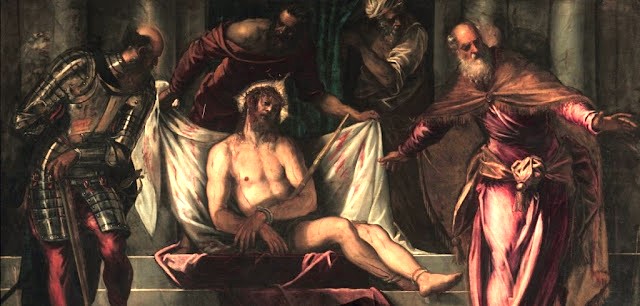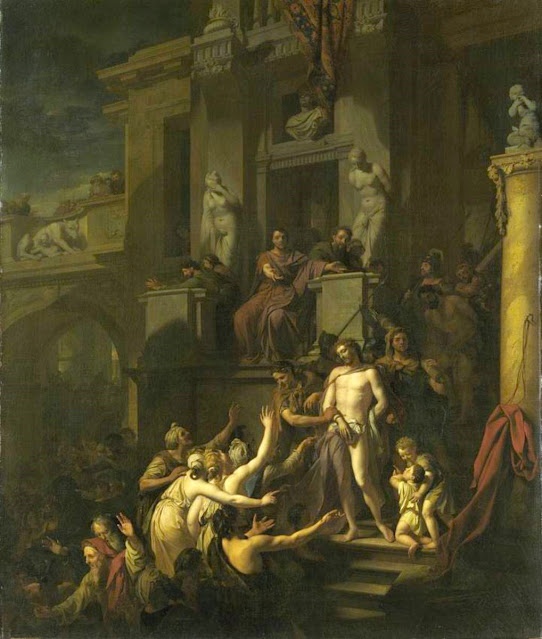 |
Maarten van Heemskerck, Ecce Homo Central panel of a triptych Dutch, c. 1559-1560 Haarlem, Frans Halsmuseum |
"Once more Pilate went out and said to them, “Look, I am bringing him out to you,
so that you may know that I find no guilt in him.”
So Jesus came out, wearing the crown of thorns and the purple cloak.
And he said to them, “Behold, the man!"
(John 1:4-5)
Excerpt from the Passion of Jesus Christ According to John
In the Latin Vulgate the final sentence in the excerpt from John, above, reads “Et dicit eis, “Ecce homo!” It is from these final words that another type of image, which meditates on the Passion of Christ, takes its name. This is the image known as “Ecce Homo”, which occurs in at least two variations.
The first, and most obvious, is an image that describes the Gospel event. Jesus and Pilate appear together, frequently on a balcony or terrace, in front of a group or crowd of people. Jesus wears the crown of thorns and a red cloak (not usually a purple one). Sometimes He is shown with a reed that appears to have been thrust into his manacled hands, so that one cannot say that He is actually holding it. He often appears highly bloodied from the scourging.
The second type of Ecce Homo image is more intimate. It brings the viewer into the position of someone standing in front of Christ. We become Pilate or a soldier or a member of the crowd. This image should be distinguished from the Man of Sorrows image, to which it has some resemblance and with which it is frequently confused, even bey artists.
Although some Ecce Homo images are devotional, most are narrative. The Jesus depicted in them is still very much alive. Images of the Man of Sorrows are always devotional and the Jesus depicted in them is, with very few early exceptions, is always dead.
Examples of each type abound, especially in Northern Europe.
The Narrative Image
 |
| Rambures Master, Ecce Homo From a Book of Hours French, c. 1455-1465 New York, Pierpont Morgan Library MS M 194, fol. 143r |
 |
| Guillaume Hugueniot, Ecce Homo From the Hours of Pierre de Bosredont Flemish, c. 1460-1475 New York, Pierpont Morgan Library MS G 55, fol. 35r |
 |
| Jean Colombe and Workshop, Ecce Homo From a Book of Hours French (Bourges), c. 1475-1485 New York, Pierpont Morgan Library MS M 330, fol. 39r |
 |
| Hieronymous Bosch, Ecce Homo Dutch, c. 1490 Frankfurt-am-Main, Städel Museum |
 |
| Master of the Dark Eyes, Ecce Homo From a Book of Hours Dutch, c.1490 The Hague, Koninklijk Bibliotheek MS KB 76 G 9, fol.62v |
 |
| Benedetto di Silvestro, Ecce Homo From a Vita Christi Italian, c. 1500-1550 New York, Pierpont Morgan Library MS M 508, fol. 28r |
 |
| Ecce Homo From a Book of Hours Dutch (Utrecht), c. 1500-1510 New York, Pierpont Morgan Libary MS M 166, fol. 34v |
 |
| Ecce Homo From the Ottheinrich-Bibel German (Regensburg), 16th Century Munich, Bayerische Staatsbibliothek MS BSB Cgm 8010 (5), fol. 139r |
 |
| Attributed to the Workshop of Giovanni della Robbia, Ecce Homo Italian, c. 1500-1516 San Vivaldo, Sacro Monte di San Vivaldo |
Hans Holbein the Elder, Ecce Homo
German, 1502
Munich, Bayerisches Staatsgemäldesammlungen, Alte Pinakothek
Master of James IV of Scotland, Ecce Homo
From the Spinola Hours
Flemish (Bruges), c. 1510-1520
Los Angeles, J. Paul Getty Museum
MS Ludwig IX 18, fol. 136r
Jan Joest von Kalkar, Ecce Homo
Dutch, 1508
Kalkar, Catholic Parish of Saint Nicholas
Adriaen van Overbeke, Ecce Homo
Flemish, c. 1510-1529
Private Collection
Master of the Bruges Passion Scenes, Ecce Homo
Flemish, c. 1510
London, National Gallery
Hans Schäufelein, Ecce Homo
German, 1517
Munich, Bayerische Staatsgemäldesammlungen, Alte Pinakothek
Quentin Massys, Ecce Homo
Flemish, c. 1518-1520
Madrid, Museo Nacional del Prado
Simon Bening, Ecce Homo
From the Prayer Book of Cardinal Albrecht of Brandenburg
Flemish (Bruges), c. 1525-30
Los Angeles, J. Paul Getty Museum
MS Ludwig IX 19, fol. 164v
Titian, Ecce Homo
Italian, 1543
Vienna, Kunsthistorisches Museum
Ecce Homo Window
German, c. 1550
London, Victoria and Albert Museum
Tintoretto, Ecce Homo
Italian, c. 1566-1567
Venice, Scuola Grande di San Rocco
This rather unusual image of the scene suggests that Jesus was so exhausted from the scourging he had received that he was unable to stand. Alternatively, one might say that Pilate is hoping to gain the sympathy of the crowd by presenting Jesus in this way. It seems open to interpretation.
Attributed to Hans Rottenhammer the Elder, Ecce Homo
German, 1599
Munich, Cathedral of Our Lady
Morazzone Workshop, Ecce Homo
Italian, c. 1609-1613
Varallo, Sacro Monte, Ecce Homo Chapel
This image is an unusual combination of painting and sculpture that attempts to bring the scene to life for the viewer.
After Jacques Callot, Ecce Homo
French, First Half of 17th Century
Munich, Bayerische Staatsgemäldesammlungen, Alte Pinakothek
Rembrandt van Rijn, Ecce Homo
Dutch, c. 1634
London, National Gallery
Mattia Preti, Ecce Homo
Italian, Second Half of the 17th Century
Chantilly, Musée Condé
Adriaen van der Werff, Ecce Homo
Dutch, 1698
Munich, Bayerisches Staatsgemäldesammlungen, Alte Pinakothek
Giambattista Tiepolo, Ecce Homo
Italian, 1760
Paris, Musée du Louvre
James Tissot, Ecce Homo
French, c. 1886-1894
New York, Brooklyn Museum
Antonio Ciseri, Ecce Homo
Italian, 1891
Florence, Palazzo Pitti, Galleria dell'Arte Moderna
By the end of the nineteenth century this type of image had become highly archaeological in tone.
The Devotional Image
Another, devotional type of image is more intimate. It shows a usually half-length Christ surrounded by mocking faces placed closer in the visual plane to us. Pilate may or may not be there. Following its introduction in the later medieval period, influenced no doubt by the growing popularity of the Man of Sorrows image, it gradually became the dominant image of the Ecce Homo subject in western European art.
Jean Pichore, Ecce Homo
From The Poncher Hours
French (Paris), c. 1500
Los Angeles, J. Paul Getty Museum
MS 109, fol. 194r
Andrea Mantegna, Ecce Homo
Italian, c. 1500
Paris, Musée Jacquemart-Andre
Bernardino Luini, Ecce Homo
Italian, c. 1515-1516
Cologne, Wallraf-Richartz Museum and Foundation Corboud
Attributed to Jan Mostaert, Ecce Rex Vester
Flemish, c. 1525
Brighton (UK), Brighton and Hove Museums
This image is unusual in several ways, being similar to an image of the Man of Sorrows with instruments of the Passion, but with the unusual label presented as if attached to the front of Christ's robe. This label reads "Ecce Rex Vester" ("Behold Your King") which echoes both the words used by Pilate in both the Gospels of Saint Mark (Mark 15:9 and 13) and Saint John (John 19:14, a few passages following the words "Ecce homo") when presenting Jesus to the crowd and the sign which all four Gospels suggest was placed at the top of Jesus' cross.
Correggio, Ecce Homo
Italian, c. 1525-1530
London, National Gallery
Quentin Massys, Ecce Homo
Flemish, 1526
Venice, Palazzo Ducale
Hans Hoffmann, Ecce Homo
German, c. 1580
Private Collection
Giovanni Antonio Galli, Il Spadarino, Ecce Homo
Italian, c. 1600-1625
Private Collection
Caravaggio, Ecce Homo
Italian, c. 1605
Genoa, Galleria di Palazzo Bianco
Il Cigoli, Ecce Homo
Italian, 1607
Florence, Palazzo Pitti
Anthony van Dyck, Ecce Homo
Flemish, c. 1625-1626
Birmingham (UK), Barber Institute of Fine Arts
Gioachino Assereto, Ecce Homo
Italian, c. 1640-1647
Private Collection
Juan Martin Cabezalero, Ecce Homo
Spanish, c. 1660-1672
Private Collection
Attributed to Johann Ulrich Mayr, Ecce Homo
German, c. 1670-1680
Augsburg, Lutheran Church of the Holy Cross
Ecce Homo
German, c. 1700
Regensburg, Church of Saint Blaise
Anton Raphael Mengs, Ecce Homo
German, c. 1777-1779
Bilbao, Museo de Bellas Artes
Eugene Delacroix, Ecce Homo
French, c. 1850
Private Collection
This second group of images places us in the position of the crowd howling "Crucify Him!" and invites us to consider the causes and effects of the Passion, which are our own sins and weaknesses.
© M. Duffy, 2012. Additional and updated images added 2023 and 2024.
Scripture texts in this work are taken from the New American Bible, revised edition © 2010, 1991, 1986, 1970 Confraternity of Christian Doctrine, Washington, D.C. and are used by permission of the copyright owner. All Rights Reserved. No part of the New American Bible may be reproduced in any form without permission in writing from the copyright owner.



.jpg)



















,%20Brighton%20and%20Hove%20Museums.jpg)






,%20Barber%20Institute%20of%20Fine%20Arts_2.jpg)






No comments:
Post a Comment